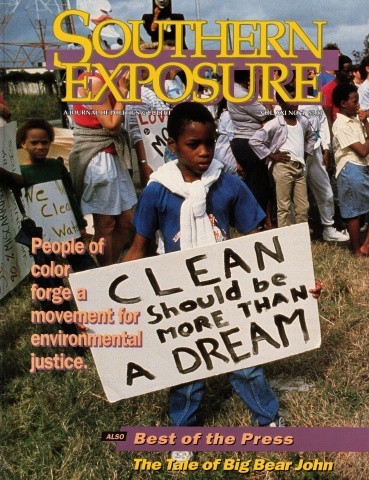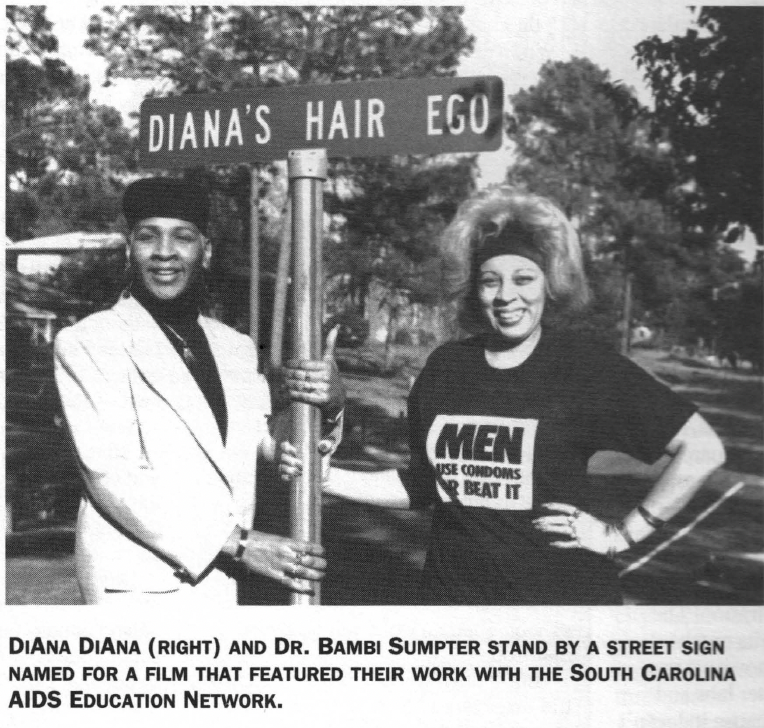
This article originally appeared in Southern Exposure Vol. 21 No. 4, "Clean Dreams." Find more from that issue here.
Acquired Immune Deficiency Syndrome was first diagnosed in the United States in the late 1970s. Since that time, AIDS has killed more than 204,000 Americans - half in the past two years alone. Another 185,000 of the one million people infected with the HIV virus are expected to die by the end of 1994.
Nearly half of those diagnosed with the virus are blacks and Latinos. Women and youth in rural Southern communities now constitute the fastest growing segment of people with AIDS.
Yet despite such alarming statistics, the federal and state governments have been slow in implementing programs to stop the spread of AIDS. In place of government inactivity, a number of grassroots organizations have emerged.
Our organization, the South Carolina AIDS Education Network, was formed eight years ago to combat the growing number of AIDS cases in our state. Like many grassroots organizations we suffer from a lack of funding, which forces us to make creative use of the resources we have. To reach more people in the community, I operate some of our AIDS educational programs out of my beauty salon, DiAna's Hair Salon.
I hand out AIDS information to all my clients when they come in the shop and show videos on AIDS prevention while they wait for their hair to dry. I also have condoms available for anyone who wants them, and keep books and other publications around so customers can read them while waiting for their appointments.
It's amazing how many people we have educated on the job. After all, if people trust hair stylists to make them look good, why not trust us to keep them healthy as well?
In the past year, we have begun helping hair stylists throughout the Southeast set up similar programs in their shops. These same people can also be valuable resources in spreading information to their schools, community groups, and churches.
Our organization has developed several techniques that we think may be of use to other grassroots groups doing similar work. While we realize that there is no one way of winning the war against AIDS, we would like to share a few lessons we have learned in our local battles:
Speak to your community in a way they can hear. Many of the communities where we work have a low literacy rate, making it impossible to simply pass out AIDS literature and instruct people to read it. To solve this problem, we asked people in the community who can draw well to create low-literacy AIDS education publications.
These books use simple, hand-drawn pictures of “sad faces” and “happy faces” to illustrate ways people can prevent AIDS. They are also careful to show people who look like the ones we are trying to educate, since people can relate more when they see familiar faces and language they can understand. As a result, we have found that the books actually have more effect in the communities where we work than government publications which cost thousands of dollars more to produce.
Train teenagers to educate their peers. Because AIDS is spreading fastest among teenagers in the rural South, we have established an "AIDS Busters" program which teaches youth from eight to 26 to go out into the community and teach "AIDS 101" to their peers. They can break it down and explain the risk of AIDS infection to friends their own age much better than an adult can. They also play a vital role in helping parents understand the types of peer pressure their children experience.
Talk about sex. We often talk about at-risk AIDS groups such as IV drug users, but let's face it - there are a lot more people having sex than sharing needles. No one wants to talk about sex in public, but everyone's doing it in private. Young boys brag about the number of children their girlfriends have, as if it is a mark of distinction to have as many kids as possible before finishing high school. This has to change.
To help reduce the chance of for us to help stop the spread of infection in our youth and to provide an educational forum for adults, we have started "Safer Sex Parties." This new method of AIDS education teaches people how to have "outercourse" instead of "intercourse" - how to have fun without sharing body fluids. It also teaches them how to use condoms, dental dams, finger cots, and latex gloves.
There is no nudity or physical contact at the parties. They are usually held in the form of a game show, a skills-building exercise designed to get people to communicate with each other and share "safer sex" ideas. If we can get parents and kids to open up to each other and talk about sex at these parties, then perhaps they will feel more comfortable talking about the subject at home.
Redefine "at risk" to include women from different backgrounds and marital status. I remember one women who told me that her doctor said she was not at risk for AIDS because she was married and didn't use drugs. This kind of misinformation plagues the medical establishment. According to the Centers for Disease Control, women will soon make up 80 percent of those diagnosed with the AIDS virus.
Yet married women and women in monogamous relationships are told that they are not at risk - a cultural stereotype that can make women afraid to demand safe sex from their partners. Many think that if they refuse to "give it up," their partner will go elsewhere.
In our training, we emphasize that everyone is at risk. We also emphasize that everyone has a right to protect themselves - regardless of marital status.
Utilize the churches. For years, many religious leaders have preached that sex without marriage is sinful, and that AIDS is a punishment from God. In the face of the growing epidemic, however, churches are starting to take a proactive role in educating their congregations about AIDS.
AIDS is a medical issue, not a moral issue, and religious leaders should be given mandatory classes on AIDS infection and how the disease is transmitted. No one can pretend to be a leader if they cannot address issues that are relevant and real to the people who attend their services.
We teach religious leaders that it's better to pray with a person beside us than from beside a graveside. Churches must continue to serve as the backbone of our community in the face of this deadly epidemic - but they must do so through AIDS education. This is not something that we can just pray away.
These lessons we have learned from fighting AIDS are by no means the only solutions to the crisis. But until there is a cure for AIDS, education represents the only safe measure to guard against the virus.
Let's be realistic. Abstinence is a worthy goal, but we have to face reality. People are having sex, and it doesn't appear that they are going to stop. In order To help reduce the chance of for us to help stop the spread of AIDS, we have to face this fact and be more open.
Like no other plague before, the AIDS epidemic threatens to wipe out an entire generation and leave another orphaned. We must not let cultural, racial, or social barriers distract us from the job that must be done. Nor can we let political ineptitude stop us from our task. This is an undeclared war that everyone must enlist in for us to win. We simply cannot let people continue to die because we don't feel comfortable talking about AIDS. Everyone must become an educator and learn to live.
Tags
DiAna DiAna
DiAna DiAna is director of the South Carolina AIDS Education Network. Her work has been featured in the film DiAna's Hair Ego: AIDS Information Up Front, and she contributed to the book Women, AIDS, and Activism. (1993)

